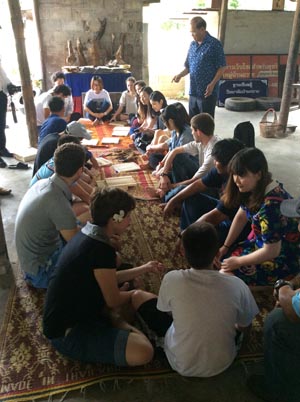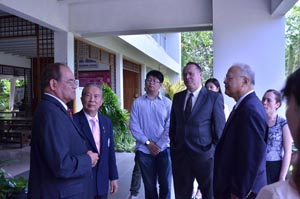STORIES TO INSPIRE
Last September, Serena found himself in one of Allred’s marketing courses. “He said he was working on a project that was going to help save a village in Thailand,” Serena says. Serena was intrigued and was thrown into a project to co-lead a team of four undergraduate students to tell the stories of the artisans.
“We wanted to develop stories around these artisans and the woodcarving,” Serena says. “We learned about their challenges and how they learned the art and told stories that would inspire people to care.”
The majority of the stories about the artists simply trying to provide for their families through their art resonated with Serena’s heart. “As corny as it sounds, the main driver to get the MBA and skill set that comes with it is to provide for my wife and the family we plan to have,” Serena explains. “I come from a family with very little education. My parents came straight from Mexico. I saw the need and experienced the need. If my wife wants to stay home when we have children, I want to provide that for her.”
And so Serena says he deeply respects and admires the artisans who are trying to do that through their woodcarvings. “If this project helps them reach that, it is the biggest experience during my time at Purdue,” he says.
AN E-COMMERCE SITE AND SOCIAL MEDIA PRESENCE
For Thompson and a few of his classmates, the courses were not enough. So they started a student organization called the Baan Tawai Student Organization that now serves as a consulting firm for the artisans. So far, the student teams have created a website and social media presence for the artisans and their products.
Allred believes this type of experience is rare in business education but is where experiential learning should be heading. “I have to figure out how to give grades when the problems are unknown and so the solutions are unpredictable,” Allred explains. “The focus shifts from the tasks I assign and how they handle them to indentifying problems. But that’s how it is in the real world. The boss doesn’t come to you with a canned assignment and says go do this and bring it back to me. They come with problems and say find solutions. That mindset is somewhat foreign in a classroom structure.”
Allred says one his biggest challenges is moving students to that frame of mind. “It’s making the transition from the traditional classroom mindset to a problem-solving mindset,” says Allred. “They are moving into areas no one has addressed before. It can be frustrating for them. I give them a lot of freedom.”
And creating value in a brand that locals don’t even value, while half the world away, can lead to plenty of frustration. “We are coming to understand a very complex puzzle of culture, commerce, government, and more,” Allred says. “We are developing relationships and building trust. We are working in collaboration and developing friendships as we all contribute to a broader vision.”
RIDING THE ‘POO-POO TRAIN’
But sometimes things don’t always work out – Allred calls this “riding the poo-poo train” and says it is necessary for growth. On another family vacation in Thailand, Allred rented a camper van for his family to tour around the country. He purposely got it because it had air conditioning. The issue? The air conditioner was too good.
“It was like a freezer,” Allred says. “And the car reeked. The smell of urine was so intense. Our kids were young and I told them, ‘Sometimes you have to ride the poo-poo train.’ Now everytime we get in a situation that’s not as comfortable as we want, we all just say, ‘Sometimes you have to ride the poo-poo train.'”
According to Allred, riding the poo-poo train is what makes the good times so special—like finding the love of your life during an eclipse on a lava field in Hawaii or watching a community you’ve fallen in love with merge into a community that is your home. The beginnings of the latter were realized on April 14th, when university president Chavasint visited Purdue’s campus to present the university with a two-foot wooden sculpture from the artists Allred and his students have been working to preserve.
“I sat there and I smiled,” Allred says, recalling the event. “They key was to find something that had real meaning that was truly needed and architect the organization so the right relationships were established so it took on a life of its own. So people could forget me. You can’t be too worried about glorifying yourself. Something meaningful that has the potential of life 20 years down the road has to be bigger than one person. I saw that happening in this meeting. It made me smile all over. I saw the energy in the room and saw those relationships being established. That’s the foundation of any solid movement and organization. And, even better, (Xavier Thompson) put that together. He orchestrated that and is an undergraduate student.”
A TRUE LABOR OF LOVE
Still, for Allred, many events in his life lead back to one—that moment on the lava field in Hawaii. “Marrying my wife turned my world upside down,” Allred says. “Everything. From embracing cultures to engagement with others to the spirit of adventure. We love to embrace these things together and get other people to go with us. To feel the love.”
And for Allred, this current project is the epitome of that purpose.
“This project gives me something meaningful to do and build relationships that add meaning to my life,” Allred explains. When we learn to serve in various ways and use the skills we have, the service is bilateral. The last thing we want to communicate is we are the great saviors and want to fix things. When we go into other cultures they know what’s going on. They are bright people. We not only have to show respect but be in awe of what they are doing. We are building together where the whole is greater than the sum of its parts.”
DON’T MISS: CAN 10 SOPHOMORES SOLVE WORLD HUNGER?













Questions about this article? Email us or leave a comment below.